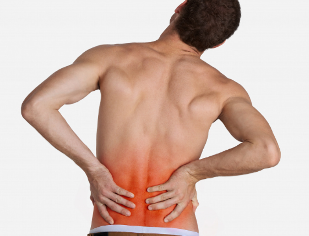Lumbar osteochondrosis is a deformity of the spine in the lumbar region. The disease affects the intervertebral discs, cartilage tissue, spinal roots and nerve fibers and causes back pain.
reasons

The main cause of the disease is the incorrect distribution of the load on the musculoskeletal system. This usually happens when you are walking in high heels, carrying a bag on one side, sleeping in an uncomfortable position, or sitting at work. At risk are older, pregnant women, those who have just given birth, professional athletes and office workers.
Other causes of lumbar osteochondrosis:
- Injuries, bruises, broken arms, legs, spine;
- Damage to the organs of the musculoskeletal system;
- gastrointestinal diseases that cause a lack of nutrients;
- body tension during prolonged exertion;
- psychoemotional disorders;
- blood flow disorders in the spine;
- inflammation of the musculoskeletal system;
- infections of the internal organs and vertebrae;
- joint stiffness, displacement of the intervertebral discs;
- protrusions and intervertebral hernias;
- severe poisoning;
- metabolic disorders;
- posture curvature;
- sedentary lifestyle;
- dehydration;
- unbalanced diet;
- lack of calcium and oxygen;
- overweight;
- bad habits;
- age-related changes;
- joint diseases.
Symptoms of lumbar osteochondrosis
The intensity and type of symptoms depend on the stage of the disease. The earlier the patient detects signs of lumbosacral osteochondrosis, the more effective the treatment will be.
General symptoms:
- severe pain in the lower back, which can radiate to the legs, internal organs of the abdomen and pelvis;
- pain in areas of the kidneys and sacrum;
- Fatigue and tension in the lower back and in the sacral spine;
- Difficulty moving, walking, bending and rotating the trunk;
- periodic back pain;
- rapid fatigue after light exertion;
- crunch in the back, limited mobility, pain in a calm state;
- numbness of the limbs;
- muscle cramps and cramps;
- dizziness;
- weakness and fatigue;
- decreased muscle tone and sensitivity
In men and women, the manifestation of lumbar osteochondrosis can be different. Men can have problems with potency. Women are more likely to experience pelvic pain. When the deformed spine cannot fully support the back, the uterus and limbs are subjected to additional stress and sometimes shift from their normal physiological position.
types
The classification of lumbar spine osteochondrosis consists of several types of the disease. The type of pain syndrome is differentiated:
Lumbago. Acute symptom. It is expressed in sharp lumbago and inability to move. It occurs with muscle spasms, injuries, pinching of intervertebral discs and nerve roots.
Lumbodynia. It is characterized by persistent aching pain caused by hernias, protrusions, spondylarthrosis, sprains, and other musculoskeletal disorders.
Lumboischialgia. Severe pain syndrome in the lumbosacral area, eradiri in the pelvis. The pain extends to the sciatic nerve, interfering with the normal flexion and extension of the body, interfering with painless sitting and standing.
Discogenic lumbar osteochondrosis and radiculopathy are also differentiated.
Discogenic lumbar osteochondrosisis associated with a loss of tenderness and numbness not only in the painful back, but also in the legs, buttocks, thighs and lower abdomen. Sometimes the body temperature rises, weakness, urinary incontinence occurs, the patient loses weight.
Radiculopathyis expressed by numbness of the nerve roots and a decrease in human motor skills. Signs - tingling or pain all over the lower trunk, reflex disturbances, decreased muscle tone and joints in the limbs.
Stages of development of lumbar osteochondrosis
Doctors follow the dynamics of the pathology in four steps:
- First. The symptoms are almost invisible - they are diagnosed on X-rays. The stage begins with pathological processes in the deliberate cavity of the overdried disk and microcracks of the annulus fibrosus.
- Second. The height of the intervertebral discs decreases, which makes the vertebrae close together. This causes the vertebrae to slide and shift, which is accompanied by pain during movement.
- Third. It is characterized by stiffness, instability, numbness of the body in the tailbone, lower back and sacrum. This can be explained by protrusion of the vertebrae, protrusions, joint dislocations and osteoarthritis in the spine.
- Fourth,. The hardest grade. The functions of the spine are disrupted and bone growth (osteophytes) is formed. The growth can pinch nerves or damage the integrity of the vertebrae.
Consequences of osteochondrosis of the lumbar spine
- Excessive accumulation of salt in the body;
- Development of hernias, protrusion, prolapse of vertebrae and intervertebral discs;
- chronic sciatica;
- Paresis and paralysis of the legs.
Diagnostics
An orthopedist, osteopath, neurologist, rheumatologist, chiropractor and surgeon can diagnose lumbar osteochondrosis and other musculoskeletal disorders. After the implementation, an exact diagnosis can be made:
- X-ray of the spine showing the condition of bone, cartilage and muscle tissue as well as ligaments and tendons.
- Myelography - examinations of the spinal cord fluid with dye. With its help, the nerve roots of the spinal cord are examined and evaluated.
Doctors use CT and MRI for a more detailed examination. They can be diagnosed in the clinic.






























